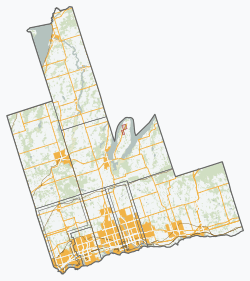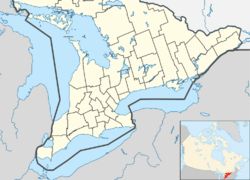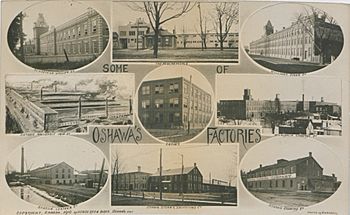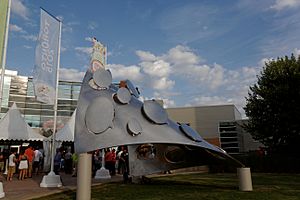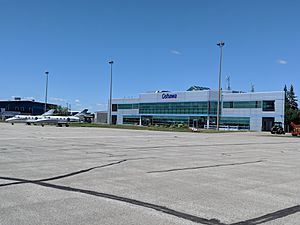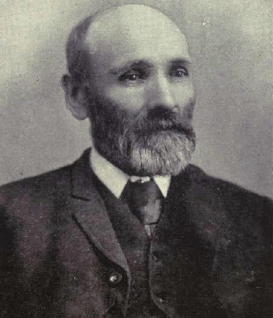Oshawa facts for kids
Quick facts for kids
Oshawa
|
|||||
|---|---|---|---|---|---|
| City of Oshawa | |||||
|
From top, left to right: Downtown Oshawa, Oshawa City Hall, GO Transit platform, Lakeridge Health, GM Canada Headquarters, Parkwood Estate and Durham College
|
|||||
|
|||||
| Nickname(s):
"Canada's Motor City"
|
|||||
| Country | Canada | ||||
| Province | Ontario | ||||
| Region | Durham Region | ||||
| Incorporated | Village: 1850
Town: 1879 City: March 8, 1924 |
||||
| Area | |||||
| • City (lower-tier) | 145.68 km2 (56.25 sq mi) | ||||
| Elevation | 106 m (348 ft) | ||||
| Population
(2021)
|
|||||
| • City (lower-tier) | 175,383 | ||||
| • Density | 1,027.0/km2 (2,660/sq mi) | ||||
| • Metro | 415,311 | ||||
| Gross Metropolitan Product | |||||
| • Oshawa CMA | CA$13.8 billion (2020) | ||||
| Time zone | UTC−05:00 (EST) | ||||
| • Summer (DST) | UTC−04:00 (EDT) | ||||
| Forward Sortation Area |
L1G to L1L
|
||||
| Area code(s) | 905, 289, 365, and 742 | ||||
Oshawa is a city in Ontario, Canada. It is located on the shore of Lake Ontario. The city is about 60 kilometers (37 miles) east of Downtown Toronto. It is often seen as the eastern part of the Greater Toronto Area. Oshawa is also the largest city in the Regional Municipality of Durham.
The name Oshawa comes from an Ojibwa word, aazhawe. This word means "the crossing place" or "a cross".
Oshawa was once known as "Canada's Motor City." This is because General Motors of Canada has its main office there. The company started as the McLaughlin Carriage Company in 1876. Today, Oshawa is also a center for education and health sciences.
The city has three colleges and universities. These include Durham College, Trent University Durham, and Ontario Tech University. Oshawa also has a large hospital, Lakeridge Health Oshawa.
Contents
History of Oshawa
Historians believe that Oshawa started as a place for the fur trade. Local Indigenous people traded furs with French traders called Coureurs des bois. Furs were put onto canoes at the Oshawa harbor. They were then taken to trading posts further west. Around 1760, the French built a trading post near the harbor. It was later left empty, but its ruins helped the first settlers.
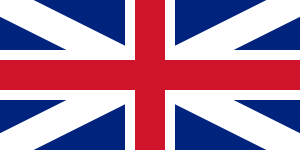
In the late 1700s, Roger Conant started a business. He shipped salmon to the United States. His success brought more people to the area. Many early settlers were United Empire Loyalists. They left the United States to live under British rule. Later, people from Ireland and French Canada also moved here.
In 1822, a road called Simcoe Street was built. It followed an old Indigenous trail. This road crossed another important road, the "Kingston Road". This crossing became known as "Skae's Corners". In 1842, the postmaster, Edward Skae, needed a better name for the community. He asked a local fur trader, Moody Farewell, for help. Farewell asked his Indigenous friends what they called the area. They said "Oshawa," meaning "where we must leave our canoes." This name was chosen for the post office. In 1850, Oshawa became a village.
The new village grew into an industrial center. Factories for wagons and other goods opened. In 1876, Robert Samuel McLaughlin, Sr. moved his carriage factory to Oshawa. He chose Oshawa because it had a harbor and was near a railway. The village became a town in 1879. The Oshawa Railway started in 1890. It provided streetcar and freight services. This connected central Oshawa to larger railway lines.
The Start of the Car Industry
In 1907, Col. R. S. McLaughlin signed a deal. His company, McLaughlin Motor Car Company, started making cars. They used Buick engines. Later, in 1915, they also started making Chevrolet cars. In 1918, McLaughlin Motor Car Company and Chevrolet Motor Car Company of Canada joined together. This created General Motors of Canada. McLaughlin became its president.
The car factory grew very quickly. Oshawa's population also grew a lot in the 1920s. In 1924, Oshawa became a city.
With his success, McLaughlin built a grand home called "Parkwood" in 1916. This large house has 55 rooms. McLaughlin lived there for 55 years with his family. Today, Parkwood is a National Historic Site of Canada. You can take tours there.
The 1937 Strike
On April 8, 1937, about 4,000 car factory workers went on strike. They wanted better pay, an eight-hour workday, and safer conditions. They also wanted their union, the United Auto Workers, to be recognized. The government at the time sided with the company. However, the union workers remained peaceful. On April 23, the company agreed to most of the workers' demands. This was an important moment for trade unions in Canada.
After World War II
After World War II, Oshawa grew even more. In 1956, the Oshawa Shopping Centre opened. This is now called the Oshawa Centre. It is the largest shopping mall east of Toronto. The opening of Highway 401 also helped the city grow. In 1974, Oshawa joined with parts of East Whitby Township. This created its current boundaries.
Many of Oshawa's older factories have closed. However, GM Canada still has its main office and a large factory here. Other important industries include making railway equipment and steel.
Climate
Oshawa has a humid continental climate. This means it has four different seasons. Temperatures change a lot between summer and winter, but they are not usually extreme.
| Climate data for Oshawa (1981−2010) | |||||||||||||
|---|---|---|---|---|---|---|---|---|---|---|---|---|---|
| Month | Jan | Feb | Mar | Apr | May | Jun | Jul | Aug | Sep | Oct | Nov | Dec | Year |
| Record high °C (°F) | 14.0 (57.2) |
11.5 (52.7) |
23.5 (74.3) |
29.5 (85.1) |
32.0 (89.6) |
34.5 (94.1) |
36.5 (97.7) |
36.0 (96.8) |
31.5 (88.7) |
24.4 (75.9) |
21.1 (70.0) |
16.5 (61.7) |
36.5 (97.7) |
| Mean daily maximum °C (°F) | −1.1 (30.0) |
0.1 (32.2) |
4.2 (39.6) |
10.8 (51.4) |
16.9 (62.4) |
22.3 (72.1) |
25.1 (77.2) |
24.3 (75.7) |
20.2 (68.4) |
13.3 (55.9) |
7.4 (45.3) |
2.1 (35.8) |
12.1 (53.8) |
| Daily mean °C (°F) | −4.8 (23.4) |
−3.6 (25.5) |
0.4 (32.7) |
6.6 (43.9) |
12.3 (54.1) |
17.6 (63.7) |
20.6 (69.1) |
20.0 (68.0) |
15.9 (60.6) |
9.5 (49.1) |
4.2 (39.6) |
−1.2 (29.8) |
8.1 (46.6) |
| Mean daily minimum °C (°F) | −8.5 (16.7) |
−7.3 (18.9) |
−3.5 (25.7) |
2.5 (36.5) |
7.7 (45.9) |
12.9 (55.2) |
15.9 (60.6) |
15.6 (60.1) |
11.7 (53.1) |
5.6 (42.1) |
1.0 (33.8) |
−4.4 (24.1) |
4.1 (39.4) |
| Record low °C (°F) | −30.5 (−22.9) |
−27 (−17) |
−24 (−11) |
−13.3 (8.1) |
−2.8 (27.0) |
1.1 (34.0) |
6.0 (42.8) |
3.0 (37.4) |
−0.6 (30.9) |
−7.8 (18.0) |
−13 (9) |
−29 (−20) |
−30.5 (−22.9) |
| Average precipitation mm (inches) | 65.6 (2.58) |
56.6 (2.23) |
54.2 (2.13) |
72.7 (2.86) |
78.9 (3.11) |
73.9 (2.91) |
73.1 (2.88) |
77.4 (3.05) |
94.0 (3.70) |
70.1 (2.76) |
84.8 (3.34) |
70.7 (2.78) |
871.9 (34.33) |
| Average rainfall mm (inches) | 30.0 (1.18) |
31.7 (1.25) |
40.7 (1.60) |
70.6 (2.78) |
78.9 (3.11) |
73.9 (2.91) |
73.1 (2.88) |
77.4 (3.05) |
94.0 (3.70) |
70.0 (2.76) |
80.0 (3.15) |
45.8 (1.80) |
766.1 (30.16) |
| Average snowfall cm (inches) | 35.6 (14.0) |
24.9 (9.8) |
13.5 (5.3) |
2.0 (0.8) |
0.0 (0.0) |
0.0 (0.0) |
0.0 (0.0) |
0.0 (0.0) |
0.0 (0.0) |
0.1 (0.0) |
4.7 (1.9) |
24.9 (9.8) |
105.8 (41.7) |
| Average precipitation days (≥ 0.2 mm) | 13.6 | 10.4 | 11.0 | 12.8 | 12.8 | 10.8 | 10.6 | 11.2 | 12.1 | 13.5 | 14.4 | 12.6 | 145.7 |
| Average rainy days (≥ 0.2 mm) | 5.7 | 5.0 | 7.9 | 12.4 | 12.8 | 10.8 | 10.6 | 11.2 | 12.1 | 13.4 | 13.3 | 7.5 | 122.7 |
| Average snowy days (≥ 0.2 cm) | 8.7 | 6.3 | 3.8 | 0.85 | 0.0 | 0.0 | 0.0 | 0.0 | 0.0 | 0.08 | 1.8 | 5.9 | 27.5 |
| Source: Environment Canada | |||||||||||||
Population and People
| Historical populations | ||
|---|---|---|
| Year | Pop. | ±% |
| 1841 | 1,000 | — |
| 1851 | 1,142 | +14.2% |
| 1861 | 2,009 | +75.9% |
| 1871 | 3,185 | +58.5% |
| 1881 | 3,992 | +25.3% |
| 1891 | 4,066 | +1.9% |
| 1901 | 4,394 | +8.1% |
| 1911 | 7,436 | +69.2% |
| 1921 | 11,940 | +60.6% |
| 1931 | 23,439 | +96.3% |
| 1941 | 26,610 | +13.5% |
| 1951 | 41,545 | +56.1% |
| 1956 | 50,412 | +21.3% |
| 1961 | 62,415 | +23.8% |
| 1966 | 78,082 | +25.1% |
| 1971 | 91,587 | +17.3% |
| 1976 | 107,023 | +16.9% |
| 1981 | 117,519 | +9.8% |
| 1986 | 123,651 | +5.2% |
| 1991 | 129,344 | +4.6% |
| 1996 | 134,364 | +3.9% |
| 2001 | 139,051 | +3.5% |
| 2006 | 141,590 | +1.8% |
| 2011 | 149,607 | +5.7% |
| 2016 | 159,458 | +6.6% |
| 2021 | 175,383 | +10.0% |
In 2021, Oshawa had a population of 175,383 people. This was a growth of about 10% since 2016. The larger Oshawa area, including nearby towns, had a population of 415,311 people.
Religions in Oshawa
In 2021, the main religious groups in Oshawa were:
- Christian: 51.4% (including Catholic and Protestant)
- No Religion/Secular: 37.3%
- Muslim: 5.8%
- Hindu: 3.7%
Languages Spoken
Most people in Oshawa speak English. In 2021, 79.5% of residents spoke English as their first language. About 1.7% spoke French. Other common languages include Urdu, Chinese, and Tagalog.
Ethnic Backgrounds
| Ethnic origin 2021 (multiple responses included) |
Population |
|---|---|
| English | 38,940 |
| Irish | 30,810 |
| Scottish | 30,415 |
| Canadian | 29,445 |
| German | 11,470 |
| French | 11,220 |
| Italian | 8,635 |
| Indian (India) | 7,445 |
| British Isles N.O.S | 7,415 |
| Polish | 5,785 |
| Dutch (Netherlands) | 5,405 |
| Jamaican | 5,315 |
| Ukrainian | 5,120 |
| Filipino | 4,545 |
Oshawa is home to people from many different backgrounds. Many residents have European roots, such as English, Irish, and Scottish. The city also has growing communities of people from South Asia, Africa, and other parts of the world.
Economy
Oshawa is the headquarters for General Motors Canada. This company has large factories and offices in the city. It provides many jobs. While GM's role has changed, it is still the biggest employer in Oshawa. In 2021, GM reopened its Oshawa car assembly plant. They started making Chevy Silverado pickup trucks there.
The downtown area of Oshawa is also important. It has government offices, the City Hall, and the Tribute Communities Centre. Ontario Tech University also has buildings downtown. Many students and staff work and study there.
Oshawa is one of the fastest-growing cities in Canada. Many people are moving to Oshawa because homes are more affordable. They can also easily travel to Toronto by train. New highways like Highway 407 and its links, Highway 412 and 418, have also helped with growth. Highways 412 and 418 became toll-free in 2022.
Oshawa has also become a popular place for filming movies and TV shows. Movies like It, Billy Madison, and X-Men have filmed scenes here. The Parkwood Estate is a favorite spot for filmmakers.
Fun Things to Do
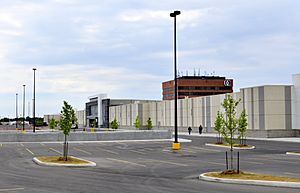
Oshawa has many parks, walking trails, and places to enjoy nature. Lakeview Park is along the shore of Lake Ontario. It has a sandy beach and is home to the Oshawa Museum. The McLaughlin Bay Wildlife Reserve and Second Marsh Wildlife Area offer protected marshlands with trails. Oshawa has over 130 parks and more than 27 kilometers (17 miles) of paved trails.
Some popular attractions in Oshawa include:
- Canadian Automotive Museum
- Ontario Regiment RCAC Museum
- The Robert McLaughlin Gallery (an art gallery)
- Tribute Communities Centre (for sports and events)
- Oshawa Museum
- Parkwood Estate (a historic home)
Oshawa hosts many yearly events. These include the Oshawa Peony Festival and Kars on King. Oshawa Fiesta Week celebrates different cultures.
The Oshawa Centre is a large shopping mall in the city center. It is the biggest mall in the Durham region.
Sports
Hockey in Oshawa
Oshawa is home to the Oshawa Generals hockey team. They play in the Ontario Hockey League. In 2015, the Generals won the Ontario Hockey League Championship and the 2015 Memorial Cup.
Many famous hockey players have played for the Oshawa Generals. These include Bobby Orr, Eric Lindros, and John Tavares. The team plays at the Tribute Communities Centre.
The Generals' home arena has burned down twice in history. This happened in 1928 and again in 1953. In 2018, Oshawa hosted its first National Hockey League preseason game.
Other Sports
Oshawa also had a basketball team, the Oshawa Power. They played in the National Basketball League of Canada. The city was also home to the Oshawa Green Gaels lacrosse team.
Windfields Farm in Oshawa was a famous horse breeding farm. It was the birthplace of Northern Dancer, a very famous racehorse. Oshawa also hosted boxing and weightlifting events for the 2015 Pan American Games.
City Services
Transportation
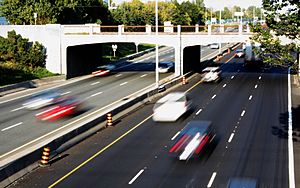
Oshawa has good transportation links. GO Transit trains connect the city to Toronto and other areas. GO Transit buses also provide service around the region. The Oshawa Station is also used by Via Rail for longer train trips. Local bus service is provided by Durham Region Transit.
The province is planning to extend the GO train service. It will go from Oshawa to Bowmanville. This will add nearly 20 kilometers (12 miles) of track and four new stations.
Major highways run through Oshawa. Highway 401 goes directly through the city. Highway 407 and its links, Highway 412 and 418, also serve the area.
The Port of Oshawa is important for shipping goods. It handles cars, steel, and other materials. The Oshawa Executive Airport handles private flights. It has customs officers on site.
Emergency Services
The Durham Regional Police Service provides policing in Oshawa. There are two police stations in the city. Ambulance services are run by the Region of Durham. Oshawa Fire Services has six fire stations.
Oshawa was the first city in Ontario to have paramedic services. In 1979, special training was given to ambulance workers. This program helped start paramedic services across Ontario.
Education
Public schools in Oshawa are managed by the Durham District School Board. There are 28 elementary schools and six high schools. The Durham Catholic District School Board oversees Catholic schools. They have 11 elementary schools and two high schools. There are also French-language public and Catholic schools.
Oshawa is home to three post-secondary schools. These are Durham College, Trent University Durham, and University of Ontario Institute of Technology (UOIT). About 22,000 students attend these schools.
Durham College has its main campus in Oshawa. It offers many different programs. University of Ontario Institute of Technology (UOIT) opened in 2003. It focuses on technology, manufacturing, and engineering. It is the only university in Canada with a degree program in Automotive Engineering. Trent University Durham also has a campus in Oshawa.
Media
Oshawa has some local media. There are two radio stations, CKDO (AM and FM) and CKGE-FM. Both are owned by Durham Radio.
Oshawa also has a local TV station, CHEX-TV-2. It shows local news for the Durham Region. Rogers Cable also has a community channel with local TV programs.
Several community newspapers serve Oshawa. These include the Oshawa Express and Oshawa This Week.
Famous People from Oshawa
- Sean Avery, NHL hockey player
- Daniel Caesar, singer-songwriter
- Allysha Chapman, soccer player for the Canada national team
- A. J. Cook, actress
- Steve Dangle, internet and sports personality
- Shirley Eikhard, songwriter
- Shalom Harlow, supermodel and actress
- Sandy Hawley, horse jockey
- Donald Jackson, Olympic figure skater
- Lennon & Maisy, country music duo and actresses
- John J. McLaughlin, inventor of Canada Dry Pale Ginger Ale
- Robert McLaughlin, founder of McLaughlin Motor Car Company
- Freddie Dredd, rapper, singer, producer
- John Part, World Darts Champion
- George Pettit, lead singer of the band Alexisonfire
- Stephen Poloz, former Governor of the Bank of Canada
- Barbara Underhill, figure skater
- Tonya Lee Williams, actress
Images for kids
See also
 In Spanish: Oshawa para niños
In Spanish: Oshawa para niños












